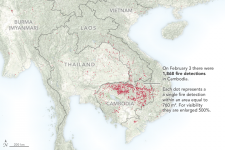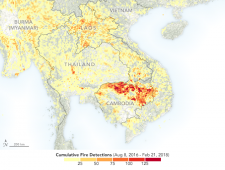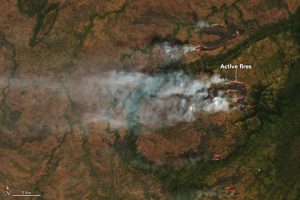Cambodia’s military crackdown recalls bloody ‘Kratie insurrection’ By: Paul Millar and Leng Len – Photography by…
Author: RFMRC SEA
Study reshapes the floral relationships between the world’s tropical forests
Study reshapes the floral relationships between the world’s tropical forests
Hannah Halusker, College of Science
Policemen, protesters hurt in Cambodian land dispute
Policemen, protesters hurt in Cambodian land dispute
Penang’s commitment to safeguard its forests
Penang’s commitment to safeguard its forests
LETTER | The recent news of continued logging in the Ulu Muda Forest Reserve, Kedah has troubled nearby residents and the rest of Malaysia.
Small logging concessions and illegal logging activities hidden from public eyes have punctured the heart of the pristine forest and affected both water source and water quality. Such activities have also snatched away homes and feeding grounds for elephants, hornbills, leopards and other protected wildlife species.
The rampant logging activity upstream of Sungai Muda consequently affects the livelihood of over four million people from three states: Kedah, Perlis, and Penang.
To be more specific, 80 percent of Penang water supply comes from Sungai Muda, 96 percent for Kedah, and 50 percent for Perlis.
Even though the Kedah Forestry Department issued a claim that there is no environmental impact from the logging activities, and water quality is not affected, this short-sighted and dubious claim fails to look at the long-term water supply issue.
These impacts of logging on human lives mean only one thing: gazette the forest reserve as water catchment area or risk our livelihood. All logging activities need to stop immediately. Delayed action will only cause more cascading effects.
The tragic fate of forests in Malaysia continues to be aggravated after the degazettement of 4,515 ha forest reserve in Terengganu earlier in January. The state government granted the land to TDM Berhad, which plans to turn the area into oil palm plantation. This move angered most environmentalists.
Read more: https://www.malaysiakini.com/letters/414558
When bogs burn, the environment takes a hit
When bogs burn, the environment takes a hit
The peat sequestered in the wet ground keeps much of Earth’s carbon out of the atmosphere
BY LAUREL HAMERS 12:00 PM MARCH 6, 2018
In 2015, massive wildfires burned through Indonesia, sending thick smoke and haze as far as Thailand.
These fires were “the worst environmental disaster in modern history,” says Thomas Smith, a wildfire expert at King’s College London. Smith estimates that the fires and smoke killed 100,000 people in Indonesia and neighboring countries and caused billions of dollars in damage. The fires were costly for the rest of the planet, too: At their peak, the blazes belched more climate-warming carbon dioxide into the atmosphere each day than did all U.S. economic activity.
Two years later and 13,000 kilometers away, a fire smoldered on the fringes of a barren, northern landscape. The remote blaze could have gone unnoticed. But Jessica McCarty and other fire researchers actively monitor satellite imagery of Earth the way some people check Facebook. One Sunday in August, McCarty, of Miami University in Ohio, was surprised to see massive plumes of what appeared to be white smoke over a swath of Greenland. The giant landmass had not been on her fire radar. It’s mostly ice and the parts that don’t have sparse vegetation.
The settings of these two blazes couldn’t have been more different, but scientists suspect the two had something important in common: plenty of decaying organic matter known as peat.
Peatlands — which include bogs, other swampy wetlands and, yes, Greenland’s icy soil — are ecosystems rich in the decayed organic matter.
In their healthy, soggy state, peatlands are quite fire resistant. So when it comes to fire risk, peat-heavy landscapes haven’t historically gotten the same attention as, say, the dry pine forests of the western United States. But with those devastating peat fires in Indonesia, the spotlight has turned to the planet’s other peatlands, too.
Worldwide, peatlands store massive amounts of carbon in thick blankets of wet organic matter accumulated in the ground over centuries. And though they cover just 3 to 5 percent of Earth’s land surface, peatlands store a quarter of all soil carbon. That adds up to more carbon than all of the world’s forests combined.
But changes in land use — draining the water to plant acres of crops that demand drier soil, a common practice in tropical regions, or building a road through an area — can dry out the peat. And then, a single carelessly tossed cigarette or an errant lightning strike can ignite a fire that will smoke and smolder for months, releasing thousands of years of stored carbon as carbon dioxide into the atmosphere.
Or fires set to clear land for agriculture can get out of hand like they’ve done in Indonesia: Over the last few decades, the country has drained many of its peatlands to grow oil palms and other crops. Now, the country is seeing the worst-case scenario of what can happen when peatlands are disrupted and desiccated. In northern latitudes, meanwhile, thawing permafrost exposes peat that has been buried for years, which can fuel fires like those seen in Greenland last summer.
In the short term, peat fires clog the air with deadly smoke and smog. In densely populated areas such as Indonesia, blazes can devour homes and businesses and claim lives. But the fires’ impact lingers long after the flames die down. Peat fires reshape entire ecosystems. Once the peat burns away, it can take thousands of years to build up again. And all of the carbon that was once neatly stored away is instead floating around in the atmosphere, contributing to climate change much like burning coal does.
Now, scientists are trying to get a better handle on peatlands and the effects of agriculture, development and a climate that’s shifting toward warmer and drier. Recent discoveries of hidden peatlands in Africa and South America expand the extent of peat around the world, and up the stakes for protecting those carbon stores. New research is making it increasingly clear that, without a shift in approach, humans might strip away healthy peatlands and get, in return, a lot of climate-warming carbon dioxide.
Read more: https://www.sciencenews.org/article/bogs-peatlands-fire-climate-change
Cambodia tops region for fires detected from space
Cambodia tops region for fires detected from space
Rescued skier offers thanks
Rescued skier offers thanks
A rescued skier thanked members of Douglas County Sheriff’s Search and Rescue for coming to his aid.
“The incredible and selfless work that you do, making a real difference, is something I won’t forget until the end of my days,” he said, according to the Douglas County Sheriff’s Office.
Last week two skiers were reported lost near Mott Canyon, and the search and rescue team was toned out to assist. Searchers located the two skiers around 8 p.m.
Due to weather conditions, they were not able to be evacuated and SAR remained with the two subjects overnight, where low temperatures were in the teens.
Members of Douglas County, El Dorado, and Washoe rescue personnel were involved.
Read more: https://www.recordcourier.com/news/local/rescued-skier-offers-thanks/
Myanmar delegation visits Tahoe
Myanmar delegation visits Tahoe
Seven delegates visiting from the Republic of the Union of Myanmar in southeast Asia at least got to see snow at Lake Tahoe last week.
The delegates spent two days in Reno and visited Lake Tahoe to learn about the U.S. Forest Service Lake Tahoe Basin Management Unit’s role in natural resource management in the Tahoe Basin.
The delegation’s visit was made possible through the International Visitor Leadership Program and was coordinated by the University of Nevada Reno’s Northern Nevada International Center.
Tahoe Fuels Battalion Chief Kyle Jacobson and Timber Management Officer Robert Guebard facilitated a field visit for the delegation to a recent forest thinning project near Pope Beach and the Emerald Fire area.
Launched in 1940, the Leadership Program supports U.S. engagement with countries around the world in order to cultivate lasting relationships by connecting current and emerging leaders with their American counterparts.
Read more: https://www.recordcourier.com/news/local/myanmar-delegation-visits-tahoe/
To learn more, visit https://eca.state.gov/ivlp/about-ivlp and https://www.unr.edu/nnic.
Binh Thuan faces high risk of forest fires
Binh Thuan faces a high risk of forest fires
Binh Thuan (VNA) – Over 150,000 hectares of forests in the south-central coastal province of Binh Thuan are now on high alert for fires as it is in the peak of the dry season, according to the provincial Forestry Management Department on February 27.
Heat waves put forests in Tuy Phong, Bac Binh, Ham Thuan Nam, Ham Thuan Bac, Ham Tan districts, La Gi township, Phan Thiet City in a high fire alert.
The province, where the lowest rainfall is recorded in the country, has over 370 hectares of forests.
According to the agency, numerous preventive measures have been taken in each locality and by all relevant bodies during the dry season, which begins in November and ends in April every year.
Forest protection teams have been set up at all levels, involving more than 1,000 people, while 150 forest rangers have been trained on forest fire prevention.
Read more: https://en.vietnamplus.vn/binh-thuan-faces-high-risk-of-forest-fires/127116.vnp



